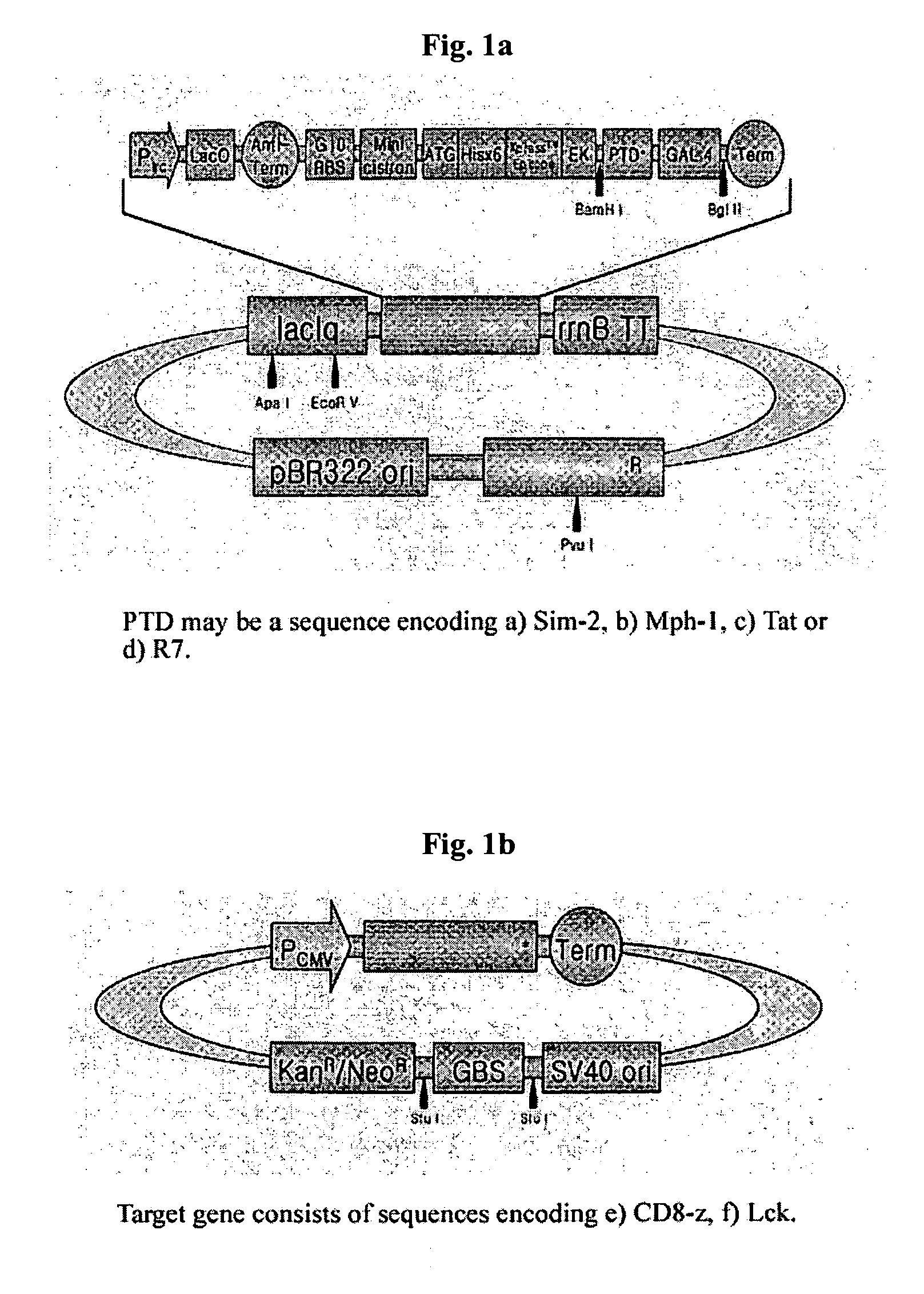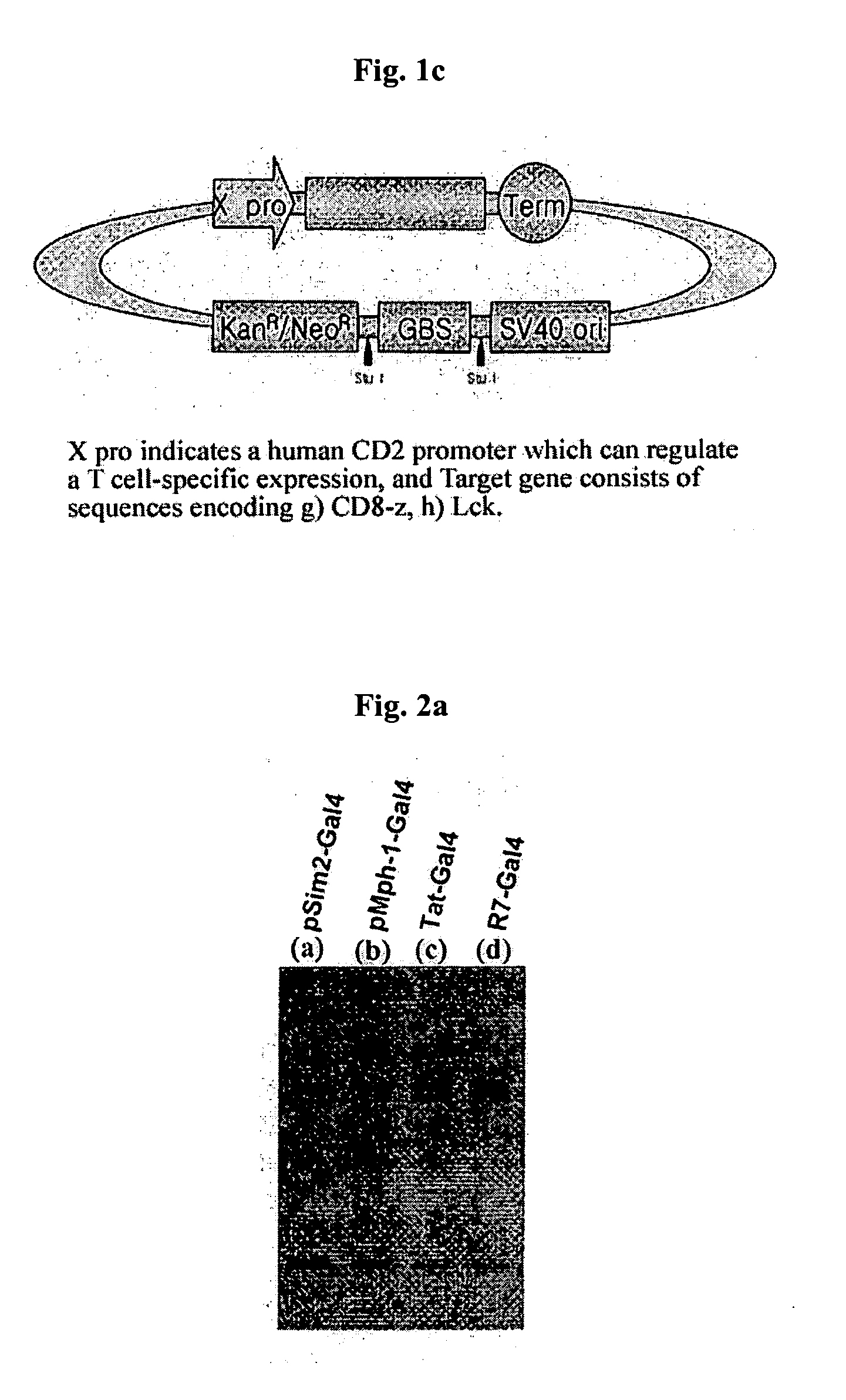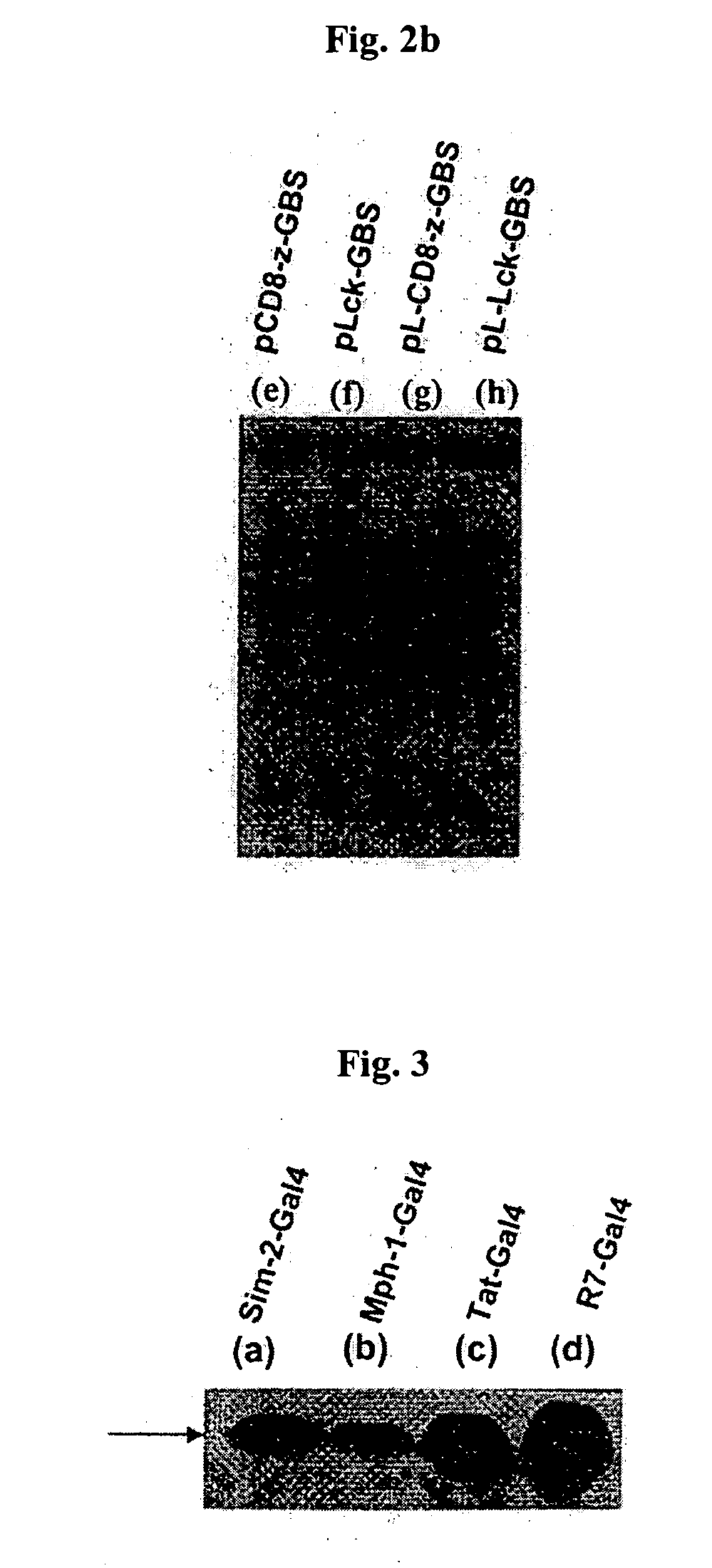DNA/RNA transduction technology and its clinical and basic applications
a transduction technology and technology of rna, applied in the field of dna/rna transduction technology and its clinical and basic applications, can solve the problems of in vivo limitations of use of these methods, inability to penetrate macromolecules, and side effects of many other cells
- Summary
- Abstract
- Description
- Claims
- Application Information
AI Technical Summary
Benefits of technology
Problems solved by technology
Method used
Image
Examples
example 1
Preparation of Recombinant Expression Vector
[0041] Preparation of Transducing Recombinant Expression Vector for Fusion Protein of Transducing Peptide with Binding Protein having DBD (pSim2-Gal4, pMph1-Gal4. pTat-Gal4, pR7-Gal4, pCD8-z-GBS).
[0042] We used Sim-2 gene (alanine at 558˜arginine at 566 from N terminus), Mph-1 gene (tyrosine at 858˜arginine at 868 from N terminus), Tat gene of HIV (tyrosine at 47˜arginine at 57 from N terminus), or base sequence encoding peptides consisting of 7 arginine amino acids as protein transducing peptides. We used Gal4 (Invitrogen) as binding proteins with DBD. In order to combine the above protein transducing peptides with base sequence encoding Gal4 to be bound to Gal4-binding sequence (GBS), SEQ ID NO: 1˜4 corresponding to primers for Sim-2, Mph-1, Tat and 7 arginines, primer of SEQ ID NO: 5 corresponding to 3′ end of Gal4 to prepare the DNA structures and BamH I site for cloning was synthesized. And then, PCR was carried out with pfu turbo D...
example 2
Preparation of E. coli Transformant and Expression and Purification of Fusion Protein
[0048]E. coli DH5 (ATCC No. 53863) was transformed with the expression vectors, pSim2-Gal4(a), pMph1-Gal4(b), pTat-Gal4(c), pR7-Gal4(d) prepared in Example 1 using heat shock transformation. Then, 2 ml of the transformant was inoculated to 100 ml of LB medium and pre-cultured with agitation at 37° C. for 12 hours. Next, after the resulting culture was inoculated to 1000 ml of LB medium and cultured at 37° C. for 4 hours, the expression of 1 ac operon was induced by adding 1 mM of IPTG (Isopropyl-D-thiogalactopyranoside, GibcoBRL cat. # 15529-019). Then, it was cultured for another 8 hours to induce the expression of fusion protein.
[0049] The above culture was centrifuged at 6,000 rpm at 4° C. for 20 minutes to remove the supernatant. The remaining pellets were dissolved in 10 ml of buffer solution 1 (50 mM NaH2PO4, 300 mM NaCl, 10 mM imidazole, pH 8.0) containing 1 mg / Me of lysozyme (Sigma, cat.# ...
example 3
Delivery and Expression of the DNA into Jurkat T cell by Sim2-Gal4, Mph1-Gal4, Tat-Gal4, or R7-Gal4 (in vivo)
[0051] After combining the fusion protein Sim2-Gal4, Mph1-Gal4, Tat-Gal4, and R7-Gal4 resulted from Example 2 with linear DNA structure pCD8-z-GBS, pLck-GBS, pINS-GBS at 37° C., 1 ml of Jurkat cells (ATCC No. TIB-152) were added to 35 mm Petri dish and reacted at 37° C. for 30 minutes. The reaction was terminated and collected cells, and the cells were reacted in 100 ml of elution buffer solution [0.2% triton X-100, 150 mM NaCl, 10 mM Tris-HCl, 400 M EDTA, 1 mM Na3VO4, 10 mM NaF, 1 mM PMSF, 10 g aprotinin, 10 g leupeptin] at 4° C. for 30 minutes and then centrifuged at 14,000 rpm for 15 minutes to obtain the cell elution solution.
[0052] This cell elution solution was separated with SDS-PAGE gel, and the expressed protein was detected through Western Blot analysis using mAb (OKT8) for CD8, mAb for Lck, mAb for INS. The result is shown in FIG. 4 (the result of INS is not show...
PUM
| Property | Measurement | Unit |
|---|---|---|
| pH | aaaaa | aaaaa |
| impermeable | aaaaa | aaaaa |
| concentration | aaaaa | aaaaa |
Abstract
Description
Claims
Application Information
 Login to View More
Login to View More - R&D
- Intellectual Property
- Life Sciences
- Materials
- Tech Scout
- Unparalleled Data Quality
- Higher Quality Content
- 60% Fewer Hallucinations
Browse by: Latest US Patents, China's latest patents, Technical Efficacy Thesaurus, Application Domain, Technology Topic, Popular Technical Reports.
© 2025 PatSnap. All rights reserved.Legal|Privacy policy|Modern Slavery Act Transparency Statement|Sitemap|About US| Contact US: help@patsnap.com



